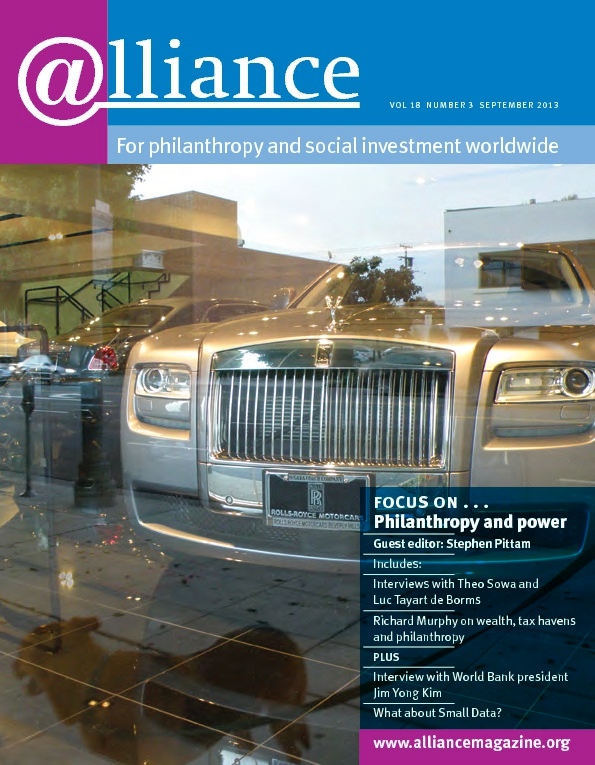‘Transparency’ is the theme of October’s Grantmakers East Forum (GEF) in Belgrade. Calling it a complex topic is an understatement. There seems to be agreement among at least this set of grantmakers that more transparency in philanthropy could be helpful. Getting specific, however, seems a challenge. For a term meant to offer clarity, it seems better at provoking additional questions.
Data is often touted as the key to transparency, with its promise to unlock secrets, help inform decisions and build better solutions. Big Data in particular is flaunted as the next new (and, therefore, best) thing. Businesses, and to a lesser extent governments, have been working hard to derive benefit from enormous amounts of information aggregated from social networks, sensors, satellite imagery, mobile phones, GPS, cars, financial markets and so on, seeking to understand the individuals behind statistics, and ultimately influence their decision-making.
Somewhere between really cool and a bit frightening, Big Data could prove important in our own search for more effective philanthropy. It holds potential to help us understand the entire value chain of our philanthropic endeavours, producing more effective grant delivery to more demonstrably effective organizations.
But few foundations are in a position to leverage Big Data’s full potential – on the one hand lacking data management resources and, on the other, serving a set of dispersed organizations that often lack the capacity to gather and share information.
So, perhaps we should start Smaller.
The term and associated philosophy of ‘Small Data’ have been gaining ground in tech-y civil society discussions of late. Recently defined by the Open Knowledge Foundation,[1] Small Data is the amount of data you can conveniently store and process on a high-end laptop. It is based in the realization that our sector’s data tends to come in much smaller sets that often become valuable only when openly shared and seen in relation to other datasets.
TechSoup’s first Small Data visualization project, for example,[2] emerged out of our desire to better understand and share the story of our network. We took a set of easily accessible data (NGO address, type, registration year, value of donation to NGO) and some economic indicators from the internet (GDP, the Economist’s Big Mac index, etc). This enabled us to look at our data in relation to a variety of other socioeconomic indicators and begin thinking differently about our impact. This was particularly interesting in parts of the world like Bulgaria where our donation programme is vastly more significant in relation to GDP than in the US, which is by far our largest market.
In the spirit of Small Data, our next step should be opening this up to others who may have a different view of civil society, say grantmakers, and beginning to understand the value of total institutional philanthropy in a country against similar comparative metrics. This sort of knowledge may in turn help us to frame more factually grounded hypotheses upon which to base and communicate our programmes.
At its June planning meeting, the GEF steering committee decided to run a transparency-related Small Data experiment around one of the region’s major ongoing concerns – dwindling philanthropic resources due to shifts in donors’ geographic priorities, which is likely to leave a considerable funding gap in years to come. Some feel that better funder collaboration could help to minimize the effects of this problem, but this is difficult to prove. Though there are relatively few funders active in the Balkans, there is no shared database of grants made.
The result? This year, when you register for GEF you will be asked to define the geography you serve and your funding priorities. The results will be aggregated and presented to attendees as a set of funding maps. Small Data projects like this may be incredibly simple, but they hold enormous value in enabling us to look into our own backyard and say ‘now we know’. Additional questions will naturally follow and shape more complex discussions and better hypotheses. Committing to those discussions and the principles of Small Data and sharing the information may enable us to better understand and express our work.
They may also help us understand what questions to ask as we begin the road to a Bigger Data reality – prepping us to use the tools that have already been employed by the for-profit sector to incorporate real-time knowledge about the behaviour of the individuals we serve; ultimately improving our understanding and enabling us to positively influence peoples’ lives.
1 http://blog.okfn.org/2013/04/26/what-do-we-mean-by-small-data
2 http://visualizations.techsoupglobal.org/growthmap
Christopher Worman is director of program development at TechSoup Global. Email cworman@techsoupglobal.org



Comments (0)